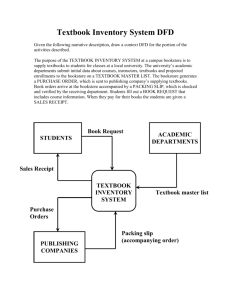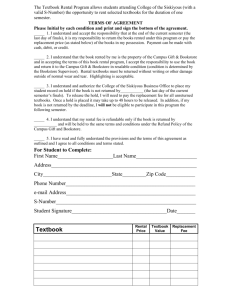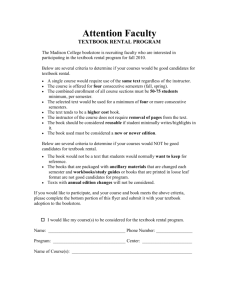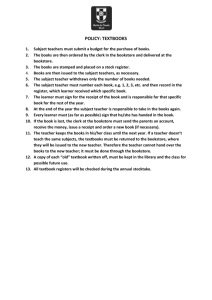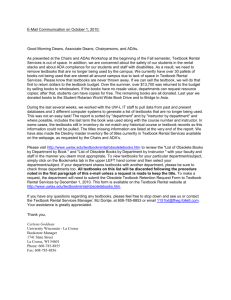HaasLuedtkePolaski
advertisement
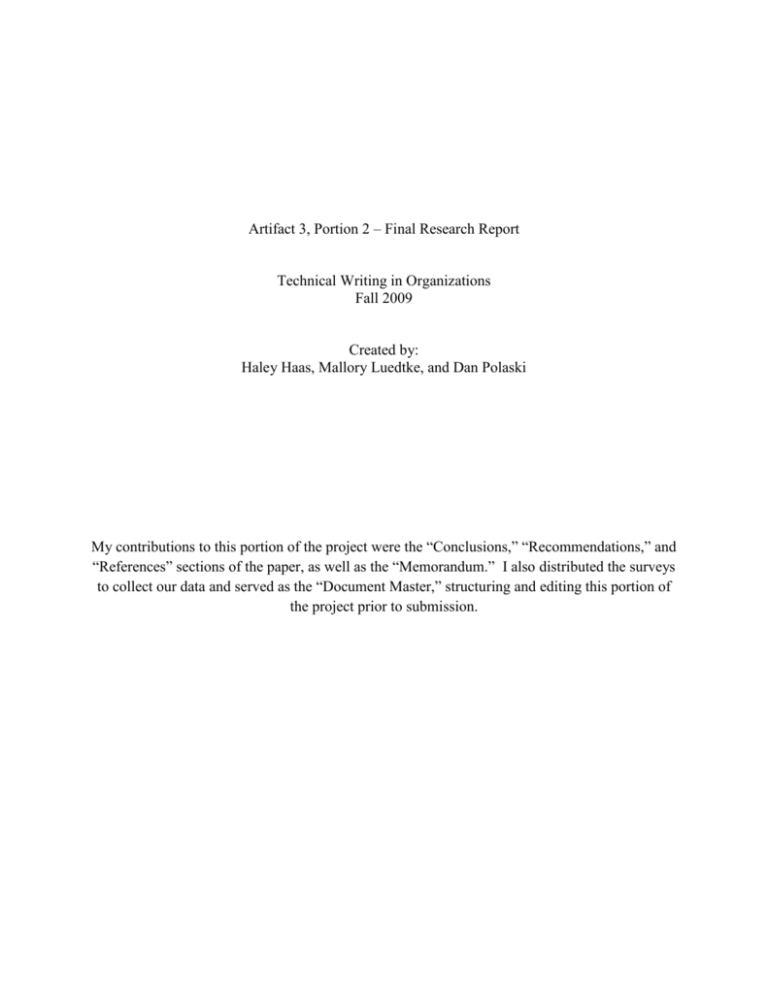
Artifact 3, Portion 2 – Final Research Report Technical Writing in Organizations Fall 2009 Created by: Haley Haas, Mallory Luedtke, and Dan Polaski My contributions to this portion of the project were the “Conclusions,” “Recommendations,” and “References” sections of the paper, as well as the “Memorandum.” I also distributed the surveys to collect our data and served as the “Document Master,” structuring and editing this portion of the project prior to submission. Memorandum TO: Carroll University Student Senate FROM: Carroll University Student Financial Advisors SUBJECT: Report on Alternative Methods of Obtaining Textbooks DATE: December 4, 2009 Summary Attached is the completion report for our study on the best alternative to traditional college textbooks. We have completed the steps outlined in our proposal of November 3, 2009. We surveyed students and interviewed bookstore managers, in addition to researching the various textbook alternatives. Discussion First, we researched the existing alternatives to traditional college textbooks. Of these alternatives, we decided that we would study further textbook rental programs, digital textbooks, and discounted book websites. We talked with the manager of the Carroll University bookstore, Andrew Ewert. He said Carroll already offers digital textbooks for several courses, and that Follett (the bookstore’s supplier) is introducing textbook rental programs in select stores. We also interviewed Barbara Young, the manager of the campus bookstore at the University of WisconsinWhitewater. She told us that their campus uses a textbook-rental system. However, their students can buy the books at the end of the semester. Our next step was to survey 50 Carroll students. We asked them how much they spent on books this semester and which alternative they felt would be best. Recommendation Based on this research, we recommend that Carroll establish a textbook rental program. If you have any questions or comments about this report, please contact us at (262) 547-1212 or advisors@carrollu.edu. Alternative Methods of Obtaining Textbooks Prepared for: Carroll University Student Senate Prepared by: Haley Haas Mallory Luedtke Dan Polaski December 4, 2009 Carroll University Student Financial Advisors 100 N. East Avenue Waukesha, WI 53186 (262) 547-1212 advisors@carrollu.edu Abstract: Alternative Methods of Obtaining Textbooks Prepared by: Haley Haas, Mallory Luedtke, and Dan Polaski Students are faced with many costs during their college years, including tuition, meal plans, and room and board. One of these expenses is the cost of purchasing textbooks. In recent years, the price of textbooks has increased significantly. As members of the Student Financial Advisors, we conducted a study to find cost-effective alternatives to buying textbooks from college bookstores. We researched three alternatives: textbook discount websites, textbook rental programs, and digital textbooks. We also interviewed two campus bookstore managers in order to learn more about the various types of textbook alternatives. Additionally, we surveyed 50 Carroll students to discover their attitudes toward the various alternatives. When researching the possible alternatives, we came up with several advantages and disadvantages of each. Based on the research, interviews, and surveys, we found that a textbook rental program, offered through the campus bookstore, would be the best alternative for Carroll students. We also suggest that the campus bookstore advertises its digital textbooks more in the future. Keywords: textbook, alternative, bookstore, rental, discount, digital ii Table of Contents Executive Summary………………………………………………………………………………………………………...1 Introduction…………………………………………………………………………………………………….....….............2 Methods……………………………………………………………………………………………………………….…...……3 Results……………………………………………………………………………………………………...…………….….…..4 Conclusions………………………………………………………………………………………………...………….……....9 Recommendations………………………………………………………………………………………...….……….….10 References……………………………………………………………………………………………………...…..……......11 Appendix A: Interview Questions for Andrew Ewert....……...……………………………………….…...12 Appendix B: Interview Questions for Barbara Young…………...…………………………….……..…….14 Appendix C: Textbook Survey for Carroll Students………………...………………………….…………....16 Appendix D: Digital Textbook Survey for CSC 220A………………...……………………………………...18 iii List of Illustrations Tables: Table 1…………………………………………………………………………………………………………………………...4 Table 2…………………………………………………………………………………………………………………………...4 Table 3…………………………………………………………………………………………………………………………...5 Figures: Figure 1………………………………………………………………………………………………………………………….5 Figure 2………………………………………………………………………………………………………………………….6 Figure 3………………………………………………………………………………………………………………………….6 Figure 4 …………………………………………………………………………………………………………………………7 Figure 5………………………………………………………………………………………………………………………….8 Figure 6………………………………………………………………………………………………………………………….8 iv Executive Summary The Carroll University Student Financial Advisors are committed to providing an affordable education for all Carroll University students. We strive to serve the entire Carroll community by monitoring the costs of college and working to keep them low. We act as an intermediary between students and administration to enhance the communication of ideas and policies. In recent years, students have seen an increase in the price of textbooks in the campus bookstore. Several factors, including the introduction of new editions, the addition of more color graphics, and the inclusion of CDs, DVDs, and other technology, have caused this increase. Students spend approximately $700 to $1,000 on textbooks annually, equating to 20% of the tuition and fees at a four-year college. This increase affects Carroll students, and the Student Financial Advisors are committed to finding a solution. To alleviate the situation, we wanted to create a program allowing students to purchase affordable alternatives to traditional textbooks. We researched several alternatives, namely discount websites (such as amazon.com), digital textbooks, and textbook rental programs. We interviewed the manager of the Carroll University bookstore, and also the bookstore manager at the University of Wisconsin-Whitewater. In addition, we surveyed 50 Carroll University students to find out which alternative they feel would be most appropriate. Some of these 50 students are members of a computer science course who already use an online textbook. We analyzed the data, and concluded that a textbook rental program, similar to the one found at UW-Whitewater, would best serve the students of Carroll University. 1 Introduction One major problem facing Carroll University students is the rising cost of textbooks. These high costs affect all students, especially those who are experiencing financial problems. The price of textbooks, added to tuition, room and board, meal plans, and other student expenses, makes the cost of receiving a college education nearly impossible. In November 2009, we received permission to carry out the research outlined in our proposal, "CostEfficiency of College Textbook Alternatives." Through this research, we wanted to find the best alternative method for students to obtain textbooks at Carroll. This recommendation report suggests the best alternative method based on cost and student preference. On average, students spend $700 to $1,000 annually on textbooks, which equates to 20% of the cost of tuition and fees at a four-year institution (Christopher, 2008, p. 11). The frequent release of new editions, “which are on average 12% more expensive than the previous edition,” adds to the problem (Christopher, 2008, p. 11). The price of textbooks also increases because publishers include color graphics and print on expensive paper. In addition, textbook companies invest in Web sites that contain supplemental information and activities, further adding to the price of the accompanying textbook. As a result, students turn to the Internet to find less expensive alternatives to campus bookstores. Internet sales for textbooks exceeded $37 billion in 2000, proving students’ interest in finding cost-efficient textbook alternatives (Foucault & Scheufele, 2002). We studied research performed by others, as well as produced our own data through interviews and surveys. This research revealed pros and cons of digital and textbook rental alternatives. It also measured students' opinions regarding the different alternatives. See Appendices A-D of this report for surveys and interview questions. This report is organized into three main sections: 1. Front matter – this section includes the letter of transmittal, title page, informative abstract, table of contents, list of illustrations, and executive summary. 2. Body – this section includes the introduction, methods, and results. It also includes our conclusions and recommendations. The body is organized chronologically, which means information is presented in order of occurrence. 3. Back matter – this section includes our reference list and appendices. There are no specialized terms in this report that need to be defined. 2 Methods E-mail Interviews To find the best alternative to purchasing traditional textbooks, we interviewed two bookstore managers via e-mail. First, we interviewed Andrew Ewert, the manager of the Carroll Bookstore. We interviewed Mr. Ewert in order to discover his future plans for the bookstore. We also wanted to glean his opinions regarding textbook alternatives. We then interviewed Barbara Young, the manager of the UW-Whitewater bookstore. Her store currently hosts a textbook rental system, and we wanted to learn how a nearby campus manages this type of program. See Appendices A and B for the interview questions and responses. Surveys We also conducted two surveys in order to gain students' perspectives on the issue. We administered surveys in the main and lower levels of the Campus Center, and also the coffee shop in the library, on November 17, 2009. Every fourth person to enter the designated areas completed a survey regarding their textbook purchasing habits and attitudes. We issued surveys in those locations because many students gather there, providing a good variety of opinions. See Appendix C for this survey. Also on November 17, 2009, students in the Computer Science 220 class, taught by Dr. Gerald Isaacs, completed a different survey. This class currently uses a digital textbook, so their survey focused on each student’s level of satisfaction with the textbook. This survey also asked the students if they would consider using a digital textbook again. See Appendix D for this survey. In addition to the interviews and surveys conducted, we studied research performed by others. We reviewed a number of different sources and scholarly journal articles to gain insight on the opinions and experiences of students at other universities around the country. See the References section of this report for a list of these sources. It should be noted that, as the research progressed, we disregarded the idea of buying textbooks through discounted websites. We felt that discounted textbook websites would not provide a business on campus, and would also be hard to promote. 3 Results 1. Advantages and Disadvantages of Textbook Alternatives The information displayed here is based on our interviews and study of existing research. a. Discount Textbook Websites See Table 1 for the advantages and disadvantages of purchasing textbooks on discount textbook websites. Table 1: Advantages and Disadvantages of Discount Textbook Websites Advantages Cheaper Possible free shipping Easy to shop around Disadvantages Untimely shipping Unable to sell back Uncertainty of product condition b. Digital Textbooks See Table 2 for the advantages and disadvantages of using digital textbooks, specifically e-Textbooks. Table 2: Advantages and Disadvantages of e-Textbooks Advantages Cheaper – about 50% savings Disadvantages Readers might be easily distracted with Twitter, Facebook, e-mail, etc. Inconvenient access (need a computer) Can electronically search document Can copy & paste sections of the book into word processing documents to act as notes Portable in devices such as iPhones and Kindles Can highlight and take notes in the textbook Can network & share notes with other students Can be affected by an inadequate Internet connection Cannot keep the textbook Pages cannot always be printed Difficult to read because of eye discomfort 4 c. Textbook Rental See Table 3 for the advantages and disadvantages of textbook rental programs. Table 3: Advantages and Disadvantages of Textbook Rental Programs Advantages Cheaper – about 55-65% savings Disadvantages May not be able to keep the textbook Don't have to worry about selling back the textbook Convenient – can get all of your books at one place Limited highlighting and writing allowed Sometimes is a better deal to buy books and later sell them back 2. Survey Results a. General Survey We found that the majority of the initial 30 students surveyed supported digital textbook alternatives. Fifty-seven percent of this sampling group said they would be interested in digital textbooks (see Figure 1). Figure 1: Percentage of Students Interested in Digital Textbook Alternatives 5 In addition, 93% of this group said they would be interested in a textbook rental program (see Figure 2). Figure 2: Percentage of Students Interested in a Textbook Rental Program However, it was discovered that only 30% of the sampling group would choose digital textbooks over a textbook rental program (see Figure 3). Figure 3: Textbook Alternative Preferneces Among Students 6 We also found that 53% of the initial 30 students spent over $500 on textbooks this semester. See Figure 4 for the breakdown of total amount spent per student. 7% 7% More than $500 13% $400-$500 $300-$400 53% $200-$300 $100-$200 20% Figure 4: Total Textbook Expenditures Per Student, Fall 2009 Term b. CSC 220 Survey We found that the majority of students in CSC 220 did not support digital textbook alternatives, either. Sixty percent of this sampling group said they would not be interested in using a digital textbook again in the future (see Figure 5, found on page 8). In addition, 60% said they prefer traditional textbooks to digital (see Figure 6, also found on page 8). CSC 220 students expressed two primary complaints regarding digital textbooks. The first was their inconvenience and unreliability when operating with a poor Internet connection. The other was that the books were hard to read, as students often experienced eye discomfort after an extended period of time. 7 Figure 5: Percentage of CSC 220 Students Interested in Using Digital Textbooks Again Figure 6: Textbook Alternative Preference Among CSC 220 Students 8 Conclusions We concluded that textbook rental is the best alternative for Carroll University students. Obtaining a textbook through a rental system is cheaper than buying a textbook. Based on the results of the initial survey, students prefer and would use a textbook rental system. The second survey provided overwhelming evidence that digital textbooks are difficult to use. A textbook rental system is possible through the Carroll bookstore because it already has a large inventory of books available for rental. Although beginning a rental program would at first require additional funds, students, as well as the bookstore, would ultimately benefit. Students will not pay as much for textbooks, prompting them to purchase other merchandise from the bookstore. This will lead to higher profits for the bookstore. 9 Recommendations We recommend establishing a textbook rental program at Carroll University. The majority of Carroll students prefer this alternative, as it benefits them in both cost and convenience. We also recommend that the Carroll Bookstore begins advertising its digital textbooks, since many students do not realize the bookstore offers this alternative. 10 References Christopher, C. L. (2008). Digital alternatives to expensive textbooks. Seybold Report: Analyzing Publishing Techniques, 8(19), 11-14. Clark, K. (2008). Bagging a textbook bargain. U.S. News &World Report, 145(6), 80. Foucault, B., & Scheufele, D. A. (2002). Web vs. campus store? Why students buy textbooks online. The Journal of Consumer Marketing, 19(5), 409-423. Kornblum, J. (2002, August 28). Students go buy the book—on the net. USA Today. Retrieved from http://www.usatoday.com. Lyman, F. (2008, October 28). E-Textbook availability expands dramatically. Community College Week, p. 8. 11 Appendix A: Interview Questions for Andrew Ewert 1) Has the Carroll Bookstore looked into any alternative options to buying textbooks such as textbook rental or digital textbooks? Is it something they are looking into for the future? Currently, we have digital textbooks, this fall we offered 33 digital titles. We have a large venue for digital content, please visit http://cafescribe.com/ this Follett's ebook site with over 6,000 titles. Cafe Scribe is also a study network. Please take time to check this site out. We believe this to be the future of textbooks. Currently, Follett is piloting textbook rental in a small number of stores. 2) What percentage of textbook sales goes directly to the bookstore and what percentage goes to Follet? Follett is a privately held company. I'm not allowed to give that information out. The average margin Wal-Mart makes is 23%. Follett's average NEW Textbook margin is 22.5%. We have a lower mark-up than Wal-Mart in relation to new textbooks. 3) What does the bookstore do with textbooks that are donated at the end of the semester (because they are not able to be bought back)? For years the Carroll Bookstore sent the donations to a program called "Bridge to Asia". The textbooks were donated to China as good will. Currently, we are donating some texts to Dr. Block's Mission in Kenya, the remaining go to the "Bridge to Asia" program. 4) Has the Carroll Bookstore had a problem with stolen textbooks due to the high cost? Textbooks are always stolen, it is a very small percentage. High cost is one factor, the other being some students try to get by without a textbook. Only to find out later that they need the text for their mid term or final. Most of our theft comes around mid-terms when a student needs the book but spent their textbook money on other things believing they could get by without the text. That's the main reason our textbook aisles are closed during the semester. 5) Do students complain to the bookstore about the high cost of textbooks? What plans does the bookstore have to alleviate these stresses? As I stated before, we have a very low markup in terms of retail pricing. We have always believed Used Textbooks to be the best solution for high text costs. When a student buys a used book they are saving 25% off the retail price if the professor uses the book in the next 12 term and we can buy the text back we'll give the student 50% back in cash. This is an overall saving of 63%. If the text were purchased as "new" we would give back 50% for an overall saving of 50%. Last year the bookstore gave back, in cash, $275,882 to Carroll students. Through our used book program we saved students an additional $176,681. For an overall savings of $452,563. Almost a half million dollars the bookstore saved students. 6) Is there a limit to the number of one particular book that the bookstore can buyback? If the book has a wholesale value there is never a limit. However, if the bookstore is buying the text for its shelves there is a limit. If there are 100 students in the fall class and only 50 students in the spring class the bookstore can only buyback 50 at half price. The 51st book goes to the wholesaler. The wholesale price can be anywhere from 0 - 25% of the new retail price. 7) Do you think the bookstore is losing sales due to students searching elsewhere for textbooks (such as amazon.com)? What does the bookstore plan to do in order to battle this competition? The bookstore's market share is strong. While students shop online, it's a buyer beware market. I know first hand of students buying textbooks online only to receive a book written in all Arabic or they receive the title weeks after classes start. While saving can be substantial online there is also great risk. You can always be guaranteed to have the right book for the right course and you can return it for a full refund. 13 Appendix B: Interview Questions for Barbara Young “The bookstore and textbook rental are both part of bookstore services, but are operated as two different entities. The rental is run with general program revenue which comes from the segregated fees that undergrad students pay with their tuition. The bookstore generates its own revenue from the sale of clothing, gifts and other textbooks not included in the rental. Books are placed into the rental program when the faculty members and departments agree to use the same book(s) for 3 years or 6 semesters. The book designated as the main textbook for a course is not subject to a maximum dollar amount. If multiple texts are used in a course the total dollar value at list price may not exceed $90. There is a $10 minimum list price for books to be placed in the rental system. Other books requested by faculty which do not fit the rental program guides are placed in the bookstore for purchase by students. This includes novels, study guides and workbooks. Graduate students do not pay the rental segregated fee and so must purchase all their textbooks. Any student who does not return their book at the end of the semester will be charged for a replacement book at the list price of new. Any books returned late are subject to a fine.” -Barbara Young 1) How long has UW-Whitewater had a textbook rental system? If they have not always had it, why did they switch? I not sure exactly when it became rental, but I know it was a rental back in the 1920's. It had been part of the Library before it was separated. The rental program works for us because it has been in existence for a very long time. Building an inventory of books to rent like we currently have would take a lot of money upfront. 2) How does the bookstore make profit off of textbook rental? Is there a significant difference between that and selling new and used textbooks? There is no profit off the textbook rental all monies is used to pay for the textbooks program. For the bookstore selling textbooks yields approximately a 3% profit. 3) Is there an initial fee students have to pay to rent unlimited textbooks, or do they pay per textbook? 14 Each undergraduate student pays a $5.45 per credit fee as part of the segregated fees. There is no limit to the number of books they check out as long as they are enrolled in the classes that use these books. 4) How much highlighting and/or writing is allowed in the rented textbooks? We encourage as little highlighting as possible but we do not fine for this. The student may be fined if there is damage beyond ordinary wear to the books. 5) Can a student keep (buy) the textbook if they wish to keep it for reference? Yes, they can purchase the rental books anytime after the semester rush is over, and they get a discount base on the age of the book. 6) What are some of the benefits that students experience because of textbook rental? The greatest benefit is the low cost of textbooks for the student. With our system they do not need money in hand when they rent the books it is paid with their tuition. Students have the books when classes begin and they tend to use them more. Also they save time looking for books for their classes. 7) What are some downsides to renting textbooks? With how our rental system works students do not tend to build a library of books for their future careers even when they have an opportunity to buy the book during the semester. With other rental programs the rental price of a book is about the same as a used book and they can't sell the books at the end of the semester. 15 Appendix C: Textbook Survey for Carroll Students What is your class standing? ___Freshman ___Junior ___Sophomore ___Senior For this semester, how much did you spend on textbooks? (Circle one) Less than $100 $301-$400 $100-$200 $401-$500 $201-$300 More than $500 Where do you buy your books? (Check all that apply) ___Campus Bookstore ___Discounted book websites (such as amazon.com or halfbooks.com) ___Book rental websites (such as chegg.com) ___Other, please specify_________________________ Did you purchase… ___New Textbooks ___Combination of both ___Used Textbooks Have you ever not bought a book simply because of its price? (Circle one) Yes No Would you be interested in digital textbook alternatives if they were offered? (Such as reading textbooks online for a cheaper price than buying textbooks) Yes No Would you be interested in a book rental system if it were offered? Yes No 16 Of the two (digital and rental), in which would you be more interested or would be more likely to use? Digital Textbook rental Rate your satisfaction of the Carroll University Bookstore. (1=very satisfied, 10=very dissatisfied) 1 2 3 4 5 6 7 8 9 Please use the back of this sheet for additional comments. 17 10 Appendix D: Digital Textbook Survey for CSC 220 Rate your overall satisfaction with your digital textbook. (1=extremely satisfied, 10= extremely dissatisfied) 1 2 3 4 5 6 7 8 9 10 If digital textbooks were offered for future classes of yours, would you buy those over a paper version? Yes No What is your biggest complaint about the digital textbook? _____________________________________________________________________________________ What is your biggest praise about digital textbook? _____________________________________________________________________________________ Which do you prefer? Digital Textbook Paper Textbook Why? _____________________________________________________________________________________ ____________________________________________________________________________________________ 18 Project Style Sheet Body Text Use 12 point Cambria font for all body text. Use 12 point Cambria for all numbers, too (See Pagination section). Citation Cite all sources using APA format. In-text citations should be used when necessary and all other sources must be included in the References section. Copies of e-mail interview questions and answers are to be put in Appendices A and B (Appendix A for Andrew Ewert and Appendix B for Barbara Young). Copies of the student surveys are in Appendices C and D (Appendix C for the general survey and Appendix D for the CSC 220 survey). Headings Use Arial Black 18 point font for main headings. Use Arial Black 12 point for subheadings. Center all main headings. Leave first-level subheadings left-aligned, and indent once for second-level subheadings. Table and Chart titles are not considered headings. See Tables and Charts section. Indentation Do not indent paragraphs; instead leave one blank line. See Returns section. Indent once for all second-level subheadings. See Headings section. Pagination Place page numbers in the bottom center of every page of the report except the letter of transmittal, title page. Use roman numerals for the Abstract, Table of Contents, and List of Illustrations. For the remaining sections, use Arabic numerals. All page numbers are to be in 12 point Cambria font. 19 Perspective Consistently use first person throughout the report. Returns Use two returns (one blank line) between headings and subheadings. Use one return (no blank line) between subheadings and body text. Use two returns between paragraphs (one blank line between paragraphs). Sections Start a new page at the beginning of every main section (example: Introduction, Methods, Conclusions, etc.). Tables and Charts Use a unifying green theme on all tables and pie charts, except for the one pie chart that contains more than two slices. Use 12 point Cambria font, centered, for table and chart titles. 20

